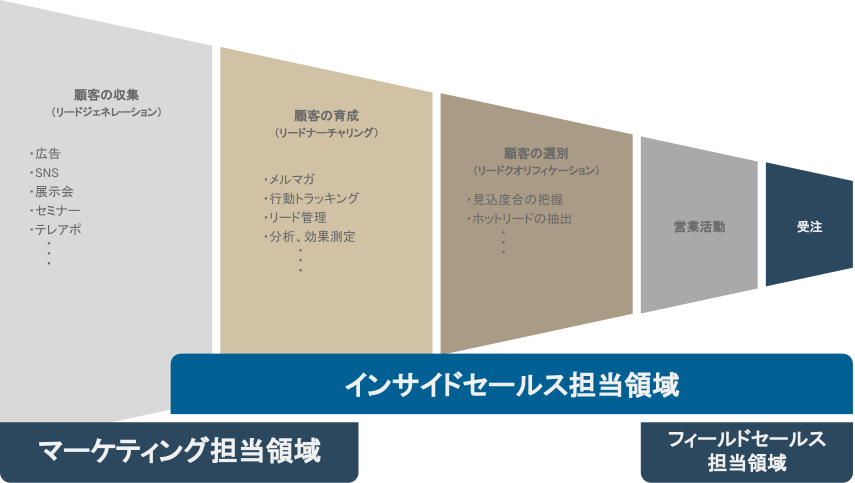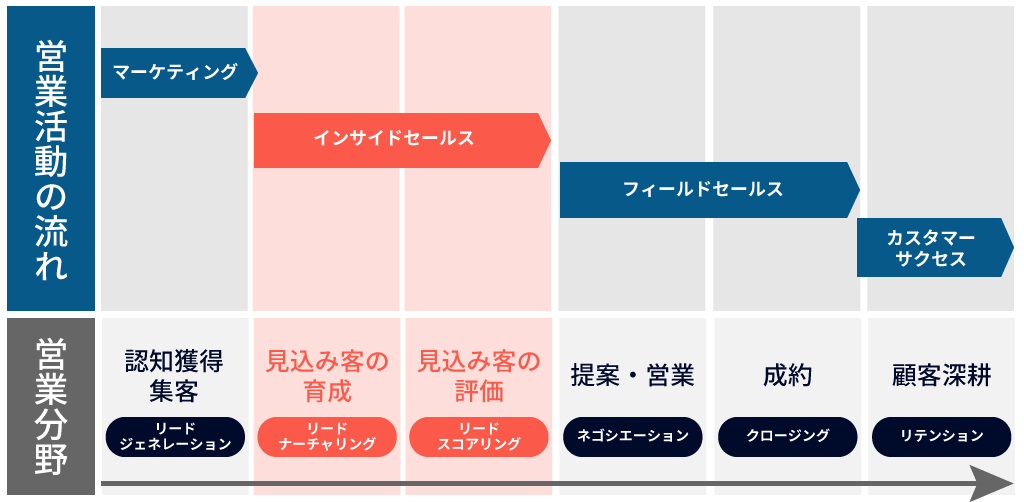As the digitalization of companies accelerates, the method of
inside sales
, in which sales activities are conducted non-face-to-face, is becoming mainstream.
In this article, we will explain the benefits of inside sales, the reasons why it is introduced, how to do it, and points to remember when implementing it.
What is inside sales?
Inside sales is conducting non-face-to-face sales without directly visiting leads (prospective customers). Inside has the meaning of “inside” or “inside”, and inside sales is called “inside sales” in Japanese.
Inside sales involves communicating with customers and conducting sales activities using tools such as email and telephone. In addition, we may also use SNS, web conferencing systems, etc.
The inside sales method was born around the 1980s in response to
the need
to cover the huge cost and time involved in traveling in the vast United States. Then, in 2008, amid the global economic crisis caused by the Lehman Shock, the trend of companies seeking to improve operational efficiency accelerated. In response to this trend, inside sales rapidly became popular, mainly in Western countries, as a method to reduce operating costs and improve efficiency.
Particularly in the United States, the ratio of inside sales to field sales in fiscal 2016 was “inside sales: 54.5%” and “field sales: 45.5%,” and the ratio of inside sales is expected to increase in the future. .

Why inside sales is attracting attention
Inside sales have long been mainstream in Europe and the United States, but in recent years they have been attracting attention in Japan as well, with an increasing number of companies adopting them. Below, we will explain why inside sales is attracting attention.
Improving business efficiency by countering labor shortages in companies
In recent years, it has become difficult for companies to secure human resources due to factors such as the declining birthrate, aging population, and work style reform. In order to compensate for the labor shortage, it is necessary to further streamline operations.
In traditional field sales, everything from obtaining appointments for sales activities to on-site business negotiations and receiving orders is performed by individual personnel, which means that customers who have no prospects are approached and travel time is required. It took quite a bit of effort.
However, with inside sales, you can conduct sales activities with a high closing rate while dividing the labor even with a small number of people.
Changes in customer purchasing process
One of the main reasons why inside sales is attracting attention is that the spread of the Internet has made it possible for people to look up the information they used to receive from sales representatives. Not only can customers collect information about services and products themselves, they can now also complete estimates and payments
online
.
This shift to a buyer-driven purchasing process has placed an emphasis on continually updating the information provided to customers and gaining customer loyalty. To achieve this, it is necessary to engage in inside sales activities that make it easy to obtain customer information.
Increase in subscription services
Subscription services, which have become popular in recent years, are a service that is compatible with inside sales. A subscription service, commonly referred to as a “subscription,” is a system that allows you to use a service or product for a certain period of time by paying a fee. Traditional “regular subscriptions” and “monthly fee systems” fall under this category, and now there are an increasing number of services that charge for automatic updates and services that offer unlimited use for a flat rate.
Due to the ease of the process from registration to start of use, which can be completed online, subscription services are expanding not only to general consumers but also to corporations. Thanks to the acceleration of digitalization, companies offering subscription services are increasingly introducing inside sales.
Popularization of non-face-to-face communication tools
When inside sales first began to be introduced, sales over the telephone were the norm. However, with the spread of the Internet, various tools and media have come to be used, including not only email but also social media such as SNS.
The development of such communication tools has made it easier to approach customers, which is also a factor in the expansion of inside sales.
Measures against new coronavirus infection
Due to the spread of the new coronavirus, companies are increasingly placing more emphasis on contactless business, including inside sales. As communication tools have evolved, telework has been encouraged and fundamental ecosystems within companies have become more efficient.
Even after the coronavirus pandemic, inside sales continues to be considered important as a method to continue effective sales activities in line with the times.

Difference between inside sales and teleappointment
Teleappointments are often confused with inside sales, but they are not the same thing. Tele-appointment is one of the inside sales approach methods, and its main purpose is to obtain appointments with prospective customers. Tele-appointment also means that the relationship with the customer is temporary.
On the other hand, inside sales aims to acquire and develop potential customers, and uses a variety of techniques, including telephone approaches. We take a variety of approaches depending on our strategy and build lasting relationships with our customers.
In addition, teleappointments usually have a “prospective client list” called a call list, and the goal of the business is to obtain as many appointments as possible from that list.
On the other hand, the goal of inside sales is
lead nurturing
, including acquiring appointments. We perform lead nurturing on the leads acquired through
lead generation
, which is in charge of marketing, and develop them into hot leads.

Difference between inside sales and field sales
While the term “inside sales” refers to in-house sales, the term “field sales” refers to door-to-door sales, which has traditionally been the mainstream.
The major difference between inside sales and field sales is whether it is “non-face-to-face (no visits)” or “face-to-face (visits).” Let’s take a closer look at each feature.
Characteristics of field sales
Field sales is the most established sales method in Japan, in which sales representatives go directly to customers to negotiate and win orders. While it is easier to build relationships of trust through face-to-face meetings, it is easy to end up negotiating with customers who are not yet fully in the consideration stage.
Characteristics of inside sales
Inside sales involves non-face-to-face sales activities, making it possible to efficiently identify potential customers with a high probability of closing a deal. Although advanced communication skills are required due to the non-face-to-face nature of the process, unnecessary visits can be reduced because the target can be narrowed down.
There are still many salespeople who are negative about inside sales.
There are still many salespeople who think face-to-face sales are the norm. Particularly in Japan, where door-to-door sales have become the mainstream business practice, and the idea that “face-to-face sales is the basics” remains deeply rooted.
Both inside sales and field sales are suitable for each situation depending on factors such as lead characteristics, market characteristics, and business format. It’s not that one is better than the other, but both have their advantages and disadvantages, so it would be better to be able to use them on a case-by-case basis.

Purpose and importance of inside sales
Inside sales is gaining more and more attention with the spread of the Internet, and here we will explain its purpose and importance in more detail.
Activities for new development
While field sales’ main purpose is to establish and close face-to-face deals, inside sales’ purpose is lead nurturing. The key point in field sales is that there is usually no customer training.
Follow up existing customers
Following up on existing customers is also one of the purposes of inside sales. In addition to telephone and email, we will follow up with customers by making full use of non-face-to-face communication tools such as SNS, chat, and web conferencing systems. We actively follow up on existing customers in order to turn them into hot leads.
Understand customer needs
Understanding customer needs is also an important objective of inside sales. By understanding customer needs and passing on the acquired information to the field sales team, field sales will be able to perform subsequent tasks more easily. Additionally, if you understand the customer’s needs in advance, you can formulate a strategy in advance about how to approach the closing for that target.
There are many ways to understand customer needs in inside sales. Typical methods include “gathering information on the Internet,” “analyzing customer data,” and “conducting surveys,” all of which can be done using business tools.
Bridging marketing and field sales
The position of an inside sales person is an intermediate position between marketing and field sales.
In marketing, after planning and sales strategies for your company’s products and services are developed and lead generation is performed, inside sales are performed on the acquired leads. Then, the flow will be to conduct field sales to the customers who have become hot leads, and to close the sale.

Inside sales role
Let’s take a closer look at the “bridging marketing and field sales” part in the previous section. In terms of bridging marketing and field sales, inside sales have two main roles:
As mentioned above, one of the characteristics of inside sales is that sales activities are divided and the role is to mediate marketing and field sales. Through non-face-to-face sales, we conduct lead nurturing to attract customer interest.
In traditional sales, a sales person is in overall charge of selecting target customers, acquiring appointments, business negotiations, receiving orders, and following up after closing. Since door-to-door sales are conducted in the order in which appointments are made, there is a limit to the number of customers that can be dealt with, and it is also difficult to approach customers according to their stage of consideration, making it difficult to achieve results.
However, in inside sales, the role and scope of responsibility vary depending on the company, but the role and scope of responsibility differs depending on the company, but the role is to continuously provide useful information to customers and attract their interest. By increasing customer loyalty while understanding their purchasing intentions and consideration stage, you will be able to focus your approach on prospective customers with a high probability of receiving an order.

Types of inside sales
Inside sales can be broadly divided into two types: The difference between the two is the way they approach leads.
SDR (Sales Development Representative): Reactive type
SDR (Sales Development Representative) is called response type in Japanese, and is a sales method that responds to leads obtained through inbound marketing. This is not a sales style where you start from scratch, but rather a sales style that responds to actions from the customer, so there is a high possibility that the need has already manifested, and the customer’s desire to purchase is often high.
BDR (Business Development Representative): New development type
On the other hand, BDR (Business Development Representative), which is called new development type in Japanese, is a sales method in which you actively approach and develop new customers. Considering that the customer’s characteristics are “new”, it is necessary to proceed with sales activities using a different approach than SDR.
Naturally, there is a high possibility that they are completely unaware of your company or its products and services, and in most cases, they have little desire to purchase. It is a sales style that has higher hurdles than SDR, as it is necessary to take these into account when formulating a sales strategy.

Benefits of inside sales
Introducing inside sales provides companies with the following main benefits:
Improving deal closing rate
Inside sales improves your closing rate by creating opportunities for business negotiations with prospective customers at the right time. By continuing to communicate, you can not only understand which customers have a high probability of closing a deal, but also approach them in accordance with the increase in customer
engagement
. Subsequent field sales personnel will be able to focus on priority customers and will be able to more easily demonstrate their abilities and skills.
Efficient and cost-effective customer service
Inside sales, which involve non-face-to-face sales, eliminates the travel time and unnecessary expenses associated with visiting customers. The saved time and costs can be spent on customer support and other tasks, leading to more efficient sales activities.
Possible to carry out sales activities with a small number of people
Traditional sales methods, which rely on visits, limit the number of customers a salesperson can approach on their own and require a large amount of human resources.
However, with inside sales, you can approach a large number of customers while staying in the office, so you can achieve results even with a small number of people. Even small and medium-sized businesses and venture companies with small sales organizations can reach a large number of customers.
In addition, by breaking away from individualized sales, information is not biased in the hands of a single salesperson, which reduces the risks associated with changes in responsibility. It will also be possible to quickly share information between marketing and field sales personnel.
Preventing customer failures
In inside sales, the history of sales activities is kept digitally, such as through IT tools and emails, making it easy to understand customer information and the status of business negotiations, making it possible to provide appropriate information tailored to the customer. Since you can follow up with customers without missing a beat, you can easily build relationships of trust and prevent customers from falling through the cracks.
Simplify your work
Inside sales tends to involve a huge amount of work, such as organizing and inputting information. However, one of the benefits of inside sales is that business tools can be used to simplify and streamline operations. The following are typical business tools that support inside sales operations.
CRM
CRM is an abbreviation for Customer Relationship Management, and it is a business tool that allows you to manage customer information. We will accumulate and manage information centered on communication, such as interactions with customers, while organizing it.
The data accumulated in CRM is useful when formulating strategies to increase “CS = customer satisfaction” and to successfully implement “upselling = improving the unit price per customer” and “cross-selling = offering additional benefits to customers.” Masu.
S.F.A.
SFA is an abbreviation for Sales Force Automation, and it is a tool that allows you to visualize sales activities and record and manage information. Since you can record and manage business negotiations with new and existing customers, you can integrate sales activities as an organization and proceed efficiently.
SFA has the ability to centrally manage sales activities and sales status for the entire organization, as well as understand the actions of each sales member. By visualizing the sales activities of the entire organization, wasteful actions and tasks of each sales member can be identified, leading to improvements in business flow and cost reduction.
M.A.
MA
is an abbreviation for Marketing Automation, which is a business tool that supports all marketing activities. In addition to being able to manage leads and use the scoring function, you can also publish lead-related analysis results as a report, making overall marketing operations more efficient. You can also design and automate different communication plans for each lead.
Furthermore, if you use MA, you can use an approach such as accumulating behavior history on the web and organizing customer situations, then ranking them (scoring) and automatically delivering different emails (step emails) depending on the rank. is also possible.
How to do inside sales
Inside sales can be implemented in six steps as explained below.
Division of roles and duties
First, set up the work flow from acquiring prospective customers to ultimately receiving orders, and clarify the roles and scope of work of each department, including inside sales. Many companies implement efficient strategies by systematically separating the three departments of marketing, inside sales, and field sales.
Build a seamless flow with a collaborative system in which the marketing department is responsible for designing events and seminars for the target audience, inside sales takes the lead in lead nurturing of prospective customers, and ultimately leads to contract closure through field sales. .
Securing human resources
Next, we will secure human resources for inside sales. There are several ways to do this, such as poaching appropriate talent from existing marketing and sales departments, or creating an inside sales department and staffing it with new talent. If there is a shortage of human resources, outsourcing is also an effective method.
KPI settings
Set KPIs that are indicators to evaluate the degree of achievement of performance goals. In inside sales, it is common to set KPIs based on indicators such as the number of calls, the number of emails sent, the number of contacts, and the number of closed deals. It is important to set it by day or month and quantify it in concrete terms.
scenario design
Scenario design is the process of planning in advance a series of flows, including the content and timing of information to be provided to potential customers. Create
a customer journey
using flowcharts and other tools so that you can take the appropriate approach to suit the customer’s situation.
Preparing the tools
What is useful for inside sales are tools that streamline management and analysis. Generally speaking, MA tools that can send bulk emails and analyze data, and CRMs that analyze customer information are often used.
Other useful tools include SFA, which is effective in managing and analyzing sales activities, and web-based business negotiation tools, which are advantageous in securing appointments. By implementing the right tools for your strategy and flow, you can conduct inside sales more efficiently.
regular feedback
Once you start selling inside, provide regular feedback. By sharing information within the company, such as the degree to which KGI has been achieved, the usefulness of tools, and the issues faced by each department, strategies can be refined, making it easier to achieve results.
summary
Inside sales is a sales method that has become mainstream in recent years due to its high efficiency. In order to lead prospective customers to a deal, it is effective to clarify the roles of each department, such as inside sales, field sales, and marketing teams, and to work by dividing and collaborating.
Let’s actively utilize convenient analysis tools and other tools to ensure appropriate staffing and build a sales flow with high cost performance. If you are a company that is facing issues with your sales system and would like to efficiently increase your closing rate, why not consider introducing inside sales?





